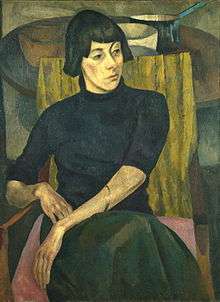Nina Hamnett
| Nina Hamnett | |
|---|---|
 1917 portrait of Nina Hamnett painted by Roger Fry (Courtauld Gallery, London) | |
| Born |
14 February 1890 Tenby, Pembrokeshire, Wales |
| Died |
16 December 1956 (aged 66) London, England |
| Nationality | British |
| Occupation | Artist and writer |
| Known for | Queen of Bohemia |


Nina Hamnett (14 February 1890 – 16 December 1956) was a Welsh artist and writer, and an expert on sailors' chanteys, who became known as the Queen of Bohemia.
Early life
Hamnett was born in the small coastal town of Tenby, Pembrokeshire, Wales, and attended the Royal School for Daughters of Officers of the Army from 1902 to 1905.[1] From 1906 to 1907 she studied at the Pelham Art School and then at the London School of Art until 1910. In 1914 she went to Montparnasse, Paris to study at Marie Vassilieff's Academy.
While studying in London she met and posed for Henri Gaudier-Brzeska who sculpted a series of nude bronzes. During this period she became friendly with Olivia Shakespear and Ezra Pound. She went on to have a love affair with Brzeska, and later with Modigliani and Roger Fry.[2]
On her first night in the Bohemian community she went to the café La Rotonde where the man at the next table introduced himself as "Modigliani, painter and Jew". In addition to making close friends with Amedeo Modigliani, Pablo Picasso, Serge Diaghilev, and Jean Cocteau, she stayed for a while at La Ruche with many of the leading members of the avant-garde living there at the time. In Montparnasse she also met her future husband, the Norwegian artist Roald Kristian.
Flamboyant lifestyle
Flamboyantly unconventional, and openly bisexual, Hamnett once danced nude on a Montparnasse café table just for the "hell of it". She drank heavily, was sexually promiscuous, and kept numerous lovers and close associations within the artistic community. Very quickly, she became a well-known bohemian personality throughout Paris and modeled for many artists. Her reputation soon reached back to London, where for a time, she went to work making or decorating fabrics, clothes, murals, furniture, and rugs at the Omega Workshops, which was directed by Roger Fry, Vanessa Bell, and Duncan Grant.[3]
Her artistic creations were widely exhibited during World War I, including at the Royal Academy in London as well as the Salon d'Automne in Paris. Back in England, she taught at the Westminster Technical Institute from 1917 to 1918. After divorcing Kristian, she took up with another free spirit, composer E. J. Moeran.
From the mid-1920s until the end of World War II, the area known as Fitzrovia was London's main Bohemian artistic centre. The place took its name from the popular Fitzroy Tavern on the corner of Charlotte and Windmill Streets that formed the area's centre. Home of the café life in Fitzrovia, it was Hamnett's favourite hangout as well as that of her friend from her home town, Augustus John, and later another Welshman, the poet Dylan Thomas.
Later life
In 1932 Hamnett published Laughing Torso, a tale of her bohemian life, which became a bestseller in the UK and US. The notorious occultist Aleister Crowley unsuccessfully sued her and the publisher for libel over allegations of black magic made in her book.
Although she won the case, the situation profoundly affected her for the remainder of her life. Alcoholism would soon overtake her many talents and the tragic "Queen of the Fitzroy" spent a good part of the last few decades of her life at the bar, (usually that of the Fitzroy Tavern), trading anecdotes for drinks.
Twenty-three years after her first book Laughing Torso was published, Hamnett, in poor health, released a follow up book aptly titled: Is She a Lady?.
Hamnett died in 1956 from complications after falling out of her apartment window and being impaled on the fence forty feet below. The great debate has always been whether or not it was a suicide attempt or merely a drunken accident. Her last words were, "Why don't they let me die?".[4]
A biography, Nina Hamnett: Queen of Bohemia, by Denise Hooker was published in 1986. In 2011, Hamnett was the subject of a short film by writer/director Chris Ward 'What Shall We Do With The Drunken Sailor' starring Siobhan Fahey.
See also
References
- ↑ Hooker, Denise (2004). "Hamnett , Nina (1890–1956)". Oxford Dictionary of National Biography. Oxford University Press. Retrieved 26 January 2013. (subscription required)
- ↑ J. J. Wilhelm. Ezra Pound in London and Paris, 1908-1925 p. 150
- ↑ Omega Workshops
- ↑ Red Flame: "Nina Hamnet (1890-1956)" at the Wayback Machine (archived June 26, 2004)
External links
| Wikimedia Commons has media related to Nina Hamnett. |
- Works by or about Nina Hamnett at Internet Archive
- Paintings by Nina Hamnett at the Art UK site
- Photograph of Nina Hamnett
- Nina Hamnett wearing an Omega cloak (left)